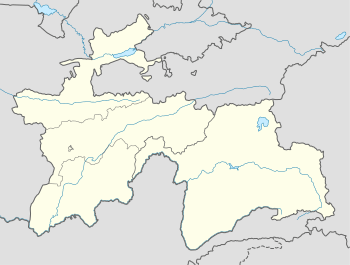Kulob
| Kulob | |
|---|---|
|
Kulob Welcoming Gate | |
 Kulob Location in Tajikistan | |
| Coordinates: 37°54′33″N 69°46′55″E / 37.90917°N 69.78194°E | |
| Country |
|
| Province | Khatlon |
| District | Kulob district |
| Population [1] | |
| • Total | 100,000 |
Kulob (Tajik: Кӯлоб / Persian: کولاب, meaning lake water, the prior an Uzbek word and latter Tajik), also Kulab or Kulyab (Russian: Куляб), is a city in Kulob district, Khatlon Province, Tajikistan. Located 203 km south-east of the capital Dushanbe on the Yakhsu River (a right tributary of Panj), it is one of the largest cities in the country and has an estimated population of 100,000. Kulob is known for being ancient, and in his histories historian Muhammad ibn Jarir al-Tabari refers to the city as early as 737AD, although its founding is said to have been much earlier. Throughout its history, Kulob was known by the name Khatlān or Khatlon in modern Tajik, with its modern name only about 250 years old. The most famous and important landmark and tourist attraction in Kulob is the mausoleum of the famous Islamic poet and scholar Mir Sayyid Ali Hamadani, which is featured on the Tajik 10 somoni bill. Kulob is also well-known for its beautiful natural surroundings, agricultural produce, and the nearby "Salt Mountain," held by Tajik legend to be made entirely of salt.
History
Part of the Khanate of Bukhara since the 16th century (the Emirate of Bukhara since the 18th century), the city changed its name from Khatlon to Kulob in 1750.[2] In 1921 Soviet rule was established.[3]
In September 2006 Kulob celebrated its 2700th anniversary.[4][5]
Geography
Climate
The Köppen Climate Classification sub-type for Kulob is "Csa" or a Mediterran Climate. The average annual temperature is 15.8°C (60.4°F). The warmest month is July with an average temperature of 28.3°C (82.9°F) and the coolest month is January with an average temperature of 2.2°C (36°F). The average annual precipitation is 468.4mm (18.4") and has an average of 72.8 days with precipitation. The wettest month is March with an average of 94.2mm (3.7") of precipitation and the driest month is August with an average of 0mm of precipitation.[6]
| Climate data for Kulob | |||||||||||||
|---|---|---|---|---|---|---|---|---|---|---|---|---|---|
| Month | Jan | Feb | Mar | Apr | May | Jun | Jul | Aug | Sep | Oct | Nov | Dec | Year |
| Daily mean °C (°F) | 2.2 (36) |
4.8 (40.6) |
10.4 (50.7) |
16.9 (62.4) |
21.2 (70.2) |
26.0 (78.8) |
28.3 (82.9) |
26.6 (79.9) |
21.8 (71.2) |
16.2 (61.2) |
10.0 (50) |
5.0 (41) |
15.8 (60.4) |
| Average precipitation mm (inches) | 53.8 (2.118) |
64.6 (2.543) |
94.2 (3.709) |
82.5 (3.248) |
59.0 (2.323) |
6.1 (0.24) |
3.7 (0.146) |
0.5 (0.02) |
1.3 (0.051) |
24.0 (0.945) |
33.9 (1.335) |
44.8 (1.764) |
468.4 (18.441) |
| Avg. precipitation days (≥ 0.1 mm) | 7.7 | 9.2 | 12.3 | 11.8 | 9.6 | 2.6 | 1.1 | 0.0 | 0.7 | 4.2 | 5.7 | 7.9 | 72.8 |
| Average relative humidity (%) | 75.5 | 72.2 | 68.0 | 63.6 | 55.0 | 39.1 | 34.0 | 35.1 | 38.4 | 49.4 | 62.4 | 71.8 | 55.4 |
| Source: "The Climate of Kulob". Weatherbase. Retrieved 2 August 2014. | |||||||||||||
Notes
- ↑ Population of the Republic of Tajikistan as of 1 January 2008, State Committee of Statistics, Dushanbe, 2008 (Russian)
- ↑ Name change from Khatlon to Kulob, 1750.
- ↑ "UNDP Kulob Area Office". About Us. UNDP Tajikistan. Retrieved 22 August 2013.
- ↑ "Kulyab 2700 years" celebrations.
- ↑ Kulyab's 2700th anniversary.
- ↑ "Climate of Kulob". Weatherbase.com. Weatherbase. Retrieved 2 August 2014.
References
- Habib Borjian, "Kulab," in Encyclopædia Iranica (available at http://www.iranica.com).
| ||||||||||||||||
